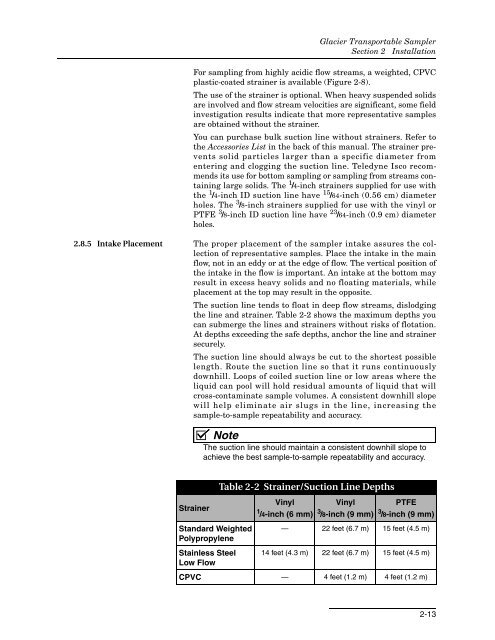Glacier Transportable Sampler - Isco
Glacier Transportable Sampler - Isco
Glacier Transportable Sampler - Isco
You also want an ePaper? Increase the reach of your titles
YUMPU automatically turns print PDFs into web optimized ePapers that Google loves.
<strong>Glacier</strong> <strong>Transportable</strong> <strong>Sampler</strong><br />
Section 2 Installation<br />
For sampling from highly acidic flow streams, a weighted, CPVC<br />
plastic-coated strainer is available (Figure 2-8).<br />
The use of the strainer is optional. When heavy suspended solids<br />
are involved and flow stream velocities are significant, some field<br />
investigation results indicate that more representative samples<br />
are obtained without the strainer.<br />
You can purchase bulk suction line without strainers. Refer to<br />
the Accessories List in the back of this manual. The strainer prevents<br />
solid particles larger than a specific diameter from<br />
entering and clogging the suction line. Teledyne <strong>Isco</strong> recommends<br />
its use for bottom sampling or sampling from streams containing<br />
large solids. The 1 /4-inch strainers supplied for use with<br />
the 1 /4-inch ID suction line have 15 /64-inch (0.56 cm) diameter<br />
holes. The 3 /8-inch strainers supplied for use with the vinyl or<br />
PTFE 3 /8-inch ID suction line have 23 /64-inch (0.9 cm) diameter<br />
holes.<br />
2.8.5 Intake Placement The proper placement of the sampler intake assures the collection<br />
of representative samples. Place the intake in the main<br />
flow, not in an eddy or at the edge of flow. The vertical position of<br />
the intake in the flow is important. An intake at the bottom may<br />
result in excess heavy solids and no floating materials, while<br />
placement at the top may result in the opposite.<br />
The suction line tends to float in deep flow streams, dislodging<br />
the line and strainer. Table 2-2 shows the maximum depths you<br />
can submerge the lines and strainers without risks of flotation.<br />
At depths exceeding the safe depths, anchor the line and strainer<br />
securely.<br />
The suction line should always be cut to the shortest possible<br />
length. Route the suction line so that it runs continuously<br />
downhill. Loops of coiled suction line or low areas where the<br />
liquid can pool will hold residual amounts of liquid that will<br />
cross-contaminate sample volumes. A consistent downhill slope<br />
will help eliminate air slugs in the line, increasing the<br />
sample-to-sample repeatability and accuracy.<br />
Note<br />
The suction line should maintain a consistent downhill slope to<br />
achieve the best sample-to-sample repeatability and accuracy.<br />
Strainer<br />
Table 2-2 Strainer/Suction Line Depths<br />
Vinyl<br />
1 /4-inch (6 mm)<br />
Vinyl<br />
3 /8-inch (9 mm)<br />
PTFE<br />
3 /8-inch (9 mm)<br />
Standard Weighted<br />
Polypropylene<br />
Stainless Steel<br />
Low Flow<br />
— 22 feet (6.7 m) 15 feet (4.5 m)<br />
14 feet (4.3 m) 22 feet (6.7 m) 15 feet (4.5 m)<br />
CPVC — 4 feet (1.2 m) 4 feet (1.2 m)<br />
2-13
















